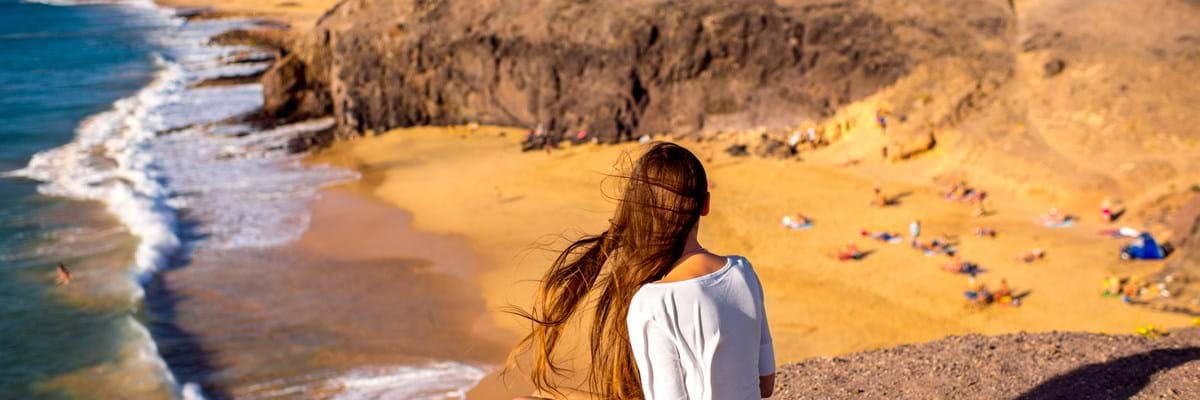Oh Lanzarote. Your name rarely flies as the first Canary from people’s lips – that’s typically Tenerife – but you’re by far the most memorable. Your sun-drenched dark lava landscape dotted with salt-white casas and bodegas is a monochrome backdrop to so many travel brochures, and your moreish Malvasías lines many a kitchen wine rack. We can never recommend Lanzarote highly enough to holidaymakers, our excitement almost palpable as we rave about its beaches, its volcanoes, its food. For those seeking sandy toes, there are copious beaches, from the sweeping golden crescent of Playa Blanca in the island’s far south to surfer’s favourite Famara at the base of towering volcanic slopes in the north. There are few enough resorts and more than enough sandy strands to spread the sunseekers out, and you’ll never feel crowded here. How we dream of shaking off our shoes and diving into the Atlantic waves on one of Lanzarote’s beaches this winter…
There’s so much more to the island than just being a place to fly and blissfully flop. It is, quite simply, gorgeous. Not here will you find high-rise buildings and roadside billboards, this is a landscape well preserved, largely thanks to the local architect and designer César Manrique, who halted later twentieth century rampant development in its cement-sodden tracks. Manrique was born in the island capital of Arrecife in 1919 and after several decades abroad, he returned to the island in 1966 with an enticing idea, that: “man was not created for this artificiality”. He saw Lanzarote as a work of art and was determined to show the rest of the world its beauty. How impossible it would be to argue that he did not succeed.
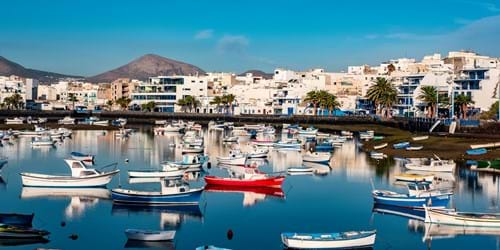
Our favourite Manrique site is the Jardín de Cactus (Cactus Garden), set in an old quarry in Guatiza. Here vast, sculptural cactus plants reach their spiky arms to the sky, piercing the blue, while smaller olive-hued cacti run in circles along the amphitheatre’s terraces, contrasting gently with the arid ebony soil and leading on to ponds where waterlilies float and brightly coloured fish dart beneath the surface. It is a delightful place to wander, and to wonder, at how man – even a man as great as Manrique – could improve on such a glorious natural landscape as Lanzarote’s.
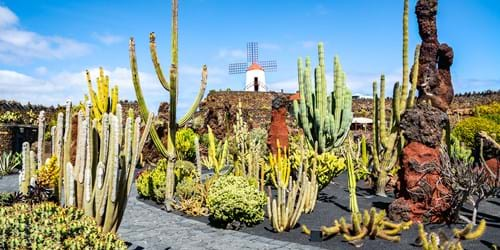
Speaking of glorious natural landscapes, no visit to Lanzarote is complete without a visit to its national park, Timanfaya. It is here that words fail us, the utterly unique cinnamon, paprika and chilli-coloured domes that are the residue of a volcanic eruption that buried the eponymous village in 1730 really do defy description. Far better, then, to visit, taking a seat on one of the coaches that depart the visitor centre and preparing for a trip to an otherworldly landscape that even as it fills up the camera roll, simply won’t allow itself to be captured. Every time you visit, you’ll notice something different – a hardy plant bursting through the soil, perhaps, or a shade of fiery crimson highlighted by the sun.
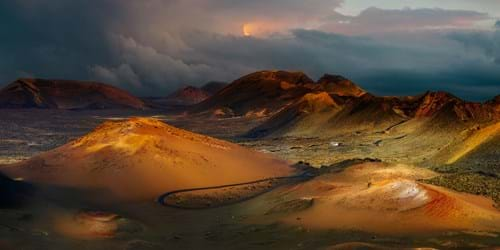
Thoughts of Lanzarote are also truly mouth-watering. On this island you can feast on some of the freshest seafood you’ll ever eat, much of it in the small seaside village of El Golfo. Here the coast is lined with simple restaurants dishing up the catch of the day and tempting passers-by onto their terraces with their sizzling grills. Sink into a chair with the sea breeze in your hair and the Atlantic tang in your nostrils, open a menu and try to decide between piping hot gambas al ajillo (garlic prawns) and beautifully blackened pulpo a la brasa (grilled octopus). Trust us, you’ll probably end up ordering both, along with a whole bocinegro (seabream), served a la espalda (on its back) with lemon wedges, papas arrugadas and mojo.
Papas arrugadas (wrinkly potatoes) and mojo sauces are served up alongside pretty much everything in Lanzarote, and we only wish we could replicate these Canarian specialities properly at home. There is something site-specific about them though, and they are by far best eaten while gazing out to sea with the sun on your face. Devour them at every opportunity, the salt crystals on the skin of the tiny potatoes clinging to your fingers, the fresh taste of the coriander-packed mojo verde (green sauce) the ideal accompaniment to any fish dish. The thing we miss most, though, is the spicier mojo rojo, its garlic, paprika and cumin a combination we could eat with just about anything.
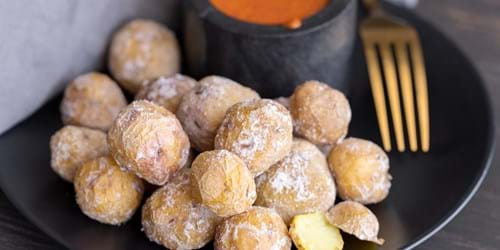
In Lanzarote, every meal must come with Malvasía volcánica. This dry but tangy wine is produced across the island’s hinterland, the vines of Malvasía grapes nourished by the fertile volcanic soil and often seen growing at the centre of zocos – crescent-shaped walls built from dark lava stones that protect them from the island’s winds. There are bodegas aplenty to visit and you can stroll around the zocos out in their vineyards, before retreating to the laidback tasting rooms of wineries such as El Grifo and Los Bermejos to indulge in a glass or two, and to buy a bottle or three to take home.
We doubt we could ever tire of Lanzarote, but even if we did, the island has one final surprise up her sleeve: Graciosa. This teeny desert island lies just offshore of Lanzarote’s northernmost coast and ferries run out here daily, bringing people – but never cars – to its shores. From here, an island where the streets are made of sand, it’s possible to look back at Lanzarote and to appreciate the island from a different angle. It’s easy to feel dwarfed by its dramatic beauty, not to mention incredibly lucky to be sitting in the sun appreciating it.
Oh Lanzarote, how we miss you…



